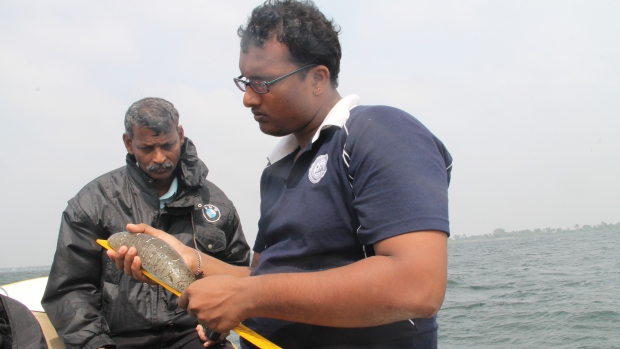Grants :: Small Grant Facilities :: Potential for sea cucumber culture in the Jaffna lagoon
Potential for sea cucumber culture in the Jaffna lagoon

Sampling sea cucumber diversity, Jaffna Lagoon © Kumudini Ekaratne/IUCN
Objectives
1. Diversity of sea cucumbers in Jaffna Lagoon assessed
2. Guidelines for site selection for sea cucumber culture formulated together with identification of suitable location
Background
Marine biodiversity in the northern coastal waters is not well studied so far, and very little information is available on sea cucumbers despite their economic importance. Details of species of sea cucumbers have not been documented fully in the Jaffna lagoon. Sea cucumber fishing in the Jaffna lagoon has increased steadily in recent years due to the high price of beech-de-mer and export demands. If the harvest of sea cucumbers continues, it will deplete resources for future generations. To overcome this, and to ensure sustainability of sea cucumber resources, beginning culture trials in the Jaffna lagoon is an exciting concept. The present research project was formulated to document species diversity of sea cucumbers in the Jaffna lagoon, to prepare guidelines for site selection for sea cucumber culture and to identify a suitable location.
The main activities that have been proposed for the project are identifying sea cucumber species in the Jaffna lagoon by sampling sea cucumbers and documenting the results, reporting the catch abundance of sea cucumbers and drafting guidelines for site selection by assessing the ecological status of selected culture sites in the Jaffna lagoon.
From the identified species, details on sea cucumber fauna can be documented and monthly catch abundance can be reported. The guidelines for site selection will utilise knowledge from fishermen, aquaculturists and researchers to initiate commercial culture trials in the Jaffna lagoon, which will enhance the socio-economic status of fishermen as well as the country.
A publication arose from this research project in the form of a book to disseminate knowledge among the community, not only in the Jaffna district, but also in Sri Lanka. Subsequent study on the potential for sea cucumber cultivation in the Jaffna lagoon will improve the livelihoods of local fishermen and further promote reconstruction and development of the fisheries sector in the Jaffna district.
Activities:
- Identifying sea cucumber species in the Jaffna Lagoon
- Assessing the ecological status of selected sea cucumber sites
- Drafting guidelines for site selection and agreement on these guidelines
- Mapping and selection of locations suitable for aquaculture
- Publishing the project output and presenting to stakeholders
Target beneficiaries
- Direct beneficiaries of the project are fishermen, exporters and aquaculturists, whereas the documentation of the findings will benefit researchers, conservationists, university students, teachers, school students and the public.
Outputs
- List of sea cucumber species and their natural habitats in the Jaffna Lagoon, catch abundance of sea cucumbers from the Jaffna Lagoon
- Identify and reporting the suitable areas for culture
- Map showing the suitable areas for sea cucumber culture
- Publication on project outputs
Accomplishments and challenges
- List of sea cucumber species and their natural habitats in the Jaffna Lagoon, catch abundance of sea cucumbers from the Jaffna Lagoon
- Map showing the suitable areas for sea cucumber culture
- Publication titled "Sea cucumbers: status and culture potential in the Jaffna lagoon, Sri Lanka"
Contributions to cross-cutting themes
1) Feature article published Nov 16, 2014, in The Sunday Times: 'Fishing for sea cucumbers--how long can this go on?'
2) Publication titled 'Sea cucumbers: status and culture potential in the Jaffna lagoon, Sri Lanka'
Lessons Learned
- Awareness on conservation and management of sea cucumber resources among the fishing community is essential. While the fishermen are at present keeping with sustainable fishing methods, it is likely that they may soon reengage in bottom trawling. Thus, continuous reminders of the consequences of such practices are required.
- Reliable baseline data which leads to future studies is essential for the stakeholders.
- Definite rules and regulations for the management of sea cucumber fisheries are not available at present. These are essential if work to protect sea cucumber populations is to succeed.
- Ban on harmful, destructive fishing methods (bottom trawling, use of strong torch light, dynamite fishing) needs to be properly implemented and maintained.
- Conservation of juvenile sea cucumbers is essential in efforts to conserve populations. When stocking cultures, aquaculturists used to collect wild juveniles from the lagoon. Recently, however, the National Aquaculture Development Authority of Sri Lanka (NAQDA) implemented a ban on this practice, thus ensuring the survival of juveniles in the wild.
- Detailed study of spawning seasons and areas needs to be conducted.
- Knowledge about the guidelines for sea cucumber culture and site selection needs to be expanded and disseminated.
Project Facts
Country
Location
Jaffna Lagoon
Topic
Duration
21st Oct 2013 to 20th Jun 2014
MFF Grant Amount
LKR 1,413,830/=
Co-financing Partner
in-kind from community = LKR 17,500/=
from Grantee (University of Jaffna) = LKR 175,000/=
Implementing Partner
Prof. Mrs. Sivashanthini Kuganathan Associate Professor & HeadDepartment of Fisheries, Faculty of ScienceUniversity of Jaffna,ThirunelvelyJaffna, Sri LankaTel: + 94 021 2222 307
email: sivashanthini@jfn.ac.lk/